UNVEILING ALTERNATE REALITIES
An interview with Joe Neill, an artist blending the real and imaginary
by Simone Suzanne Kussatz
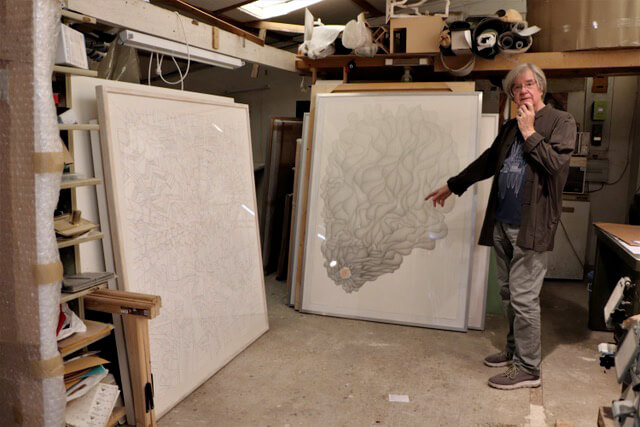
Step into the enigmatic world of Joe Neill, an American artist who works in different media, including drawing, digital drawing, sculpture, photography, India ink, and colored pencil, and whose work transcends the boundaries of reality and illusion. In our everyday lives, we may experience the peculiar sensation of being transported to another realm, where what is real might not appear as such, and illusions can mirror reality.
Neill’s creations reside within this captivating paradox, treating space as both real and artifice, inviting viewers to explore a parallel world that coexists alongside our familiar reality. Drawing inspiration from Lewis Carroll’s “Alice in Wonderland” and Cocteau’s “Orpheus,” Neill crafts imaginary forms that offer glimpses into uncharted territories. These intriguing architectures, meticulously designed with techniques reminiscent of everyday objects, become gateways to novel landscapes.
As we delve into this distinctive fusion of the known and the unknown, the question lingers: will viewers embrace the opportunity for a new experience or be intrigued by the “disturbing strangeness” before them?
I sat down with Joe Neill in his studio in Bagnolet to have a conversation about his work. Neill works with Baudoin Lebon Gallery in Paris, and his artwork is part of the public collections at prestigious institutions such as the Hirschorn Museum in Washington D.C., Yale University, Rhode Island School of Design Museum of Art, Ville de Paris, Fonds Municipal d’Art Contemporain in France, as well as the Monart Art Center in Ashdod, Israel, and the Castellani Art Museum in Niagara Falls, New York, among others.
In your artistic journey, how do you channel the influence of the wide-open spaces you mentioned in your work? Could you elaborate on how the sense of openness in physical space and thought, as experienced in America, has shaped the themes or concepts in your sculptures?
The wide-open spaces you are referring to have always been a profound inspiration for my work. In America, there used to be a sense of openness in both physical space and thought, which allowed for a certain liberty from family demands. This freedom was an opportunity for me, and without a strict family history, I chose art as my career, appreciating its endless interpretations and solutions to artistic problems. I found immense inspiration in the Gothic cathedrals of France, where a duality of thought and a meeting between the spiritual and the ordinary took place. These structures mirrored life itself and embodied both structural sophistication and spiritual intensity, something I strive to integrate into my sculptures. Similarly, Piranesi’s imaginary prisons intrigued me with their intangible elements. In my work, I aim to create sculptures rooted in the real world but offering inventive structural solutions to natural phenomena, allowing viewers to immerse themselves in an imaginary realm parallel to our own. Ultimately, I want people to experience the delights of this parallel world and be open to exploring the unknown within my art.
Your chimeric structures seem to embody a unique blend of industrial elements and imaginative forms. Could you share some specific examples of the industrial features you incorporate and how you transform them into something more ethereal and poetic?
I’m very interested in how things work – be it boats, airplanes, computers, cars, trucks, buildings, tables, tunnels, or any kind of objects. I’m fascinated by their functioning and the essence of lifelike entities, understanding how life operates and the roots of our existence. Questions about the existence of God also intrigue me. At the core, it’s about our existence – what we perceive, whether it truly reflects reality or if different perspectives shape what we see. When it comes to incorporating industrial elements, they act as background noise to me. I don’t seek to imitate them, but rather, I’m drawn to how they can inspire me and help me shape something ethereal and poetic. It’s not about copying them; rather, it’s about utilizing their essence to build upon and achieve my creative vision. My recent sculptures pay tribute to the modern “towers of Babel,” serving as monuments reaching out to the heavens from the Earth below, interacting with the universe as the Earth turns. These “Urban Dreams” possess an internal geometrical logic, dense yet open for viewers to enter, demonstrating the positive interaction between humans and Nature, reflecting the unlimited potential of ideas originating from the human mind.
The ambiguity in your art allows viewers to explore beyond the confines of reality. How do you personally navigate the balance between retaining recognizable industrial elements and venturing into the realm of abstraction?
First of all, my aim is not to imitate something entirely unrelated to my artistic vision. Instead, I strive to envision what something could look like without crossing the line into creating an exact replica. It’s like finding that balance between the unreal and the real. To achieve this, I set up guardrails for myself, ensuring I don’t venture too far into the realm of reality. This consciousness guides my creative process. In the real world, factories offer a plethora of fascinating elements, some more captivating than others. I allow myself to be influenced by these real-world aspects, always avoiding direct imitation. My drawings stem from memories and an intuitive gut feeling, as I don’t refer to factory pictures while creating them. As a result, my drawings are entirely products of imagination.
Could you please provide some context regarding your early works and the progression that led to the creation of your sculptures displayed in front of the Louvre, and subsequently, your Parallel World series?
My work has always centered around the concept of space and our interactions with objects, including people. In the early stages, I created a series of ladder-like pieces collectively referred to as “function objects.” These works were inspired by everyday objects like buses, bridges, road systems, beds, tents, and tables. They represented localized spaces and explored our relationships with space, objects, and individuals.
Over time, my focus evolved from localized spaces to geographical spaces, then universal spaces, and eventually back to architectural spaces, all while maintaining a connection to our physical relationships with these different types of spaces. The current body of work continues in a similar vein, though it may have a slightly more localized approach, still exploring themes of space, function, and human interactions.
Notably, the sculptures displayed in front of the Louvre took an abstracted, symbolic, and minimalist approach. The architectural-like tower symbolized everything created by humans, while the surrounding structure represented the space in which this human activity unfolds.
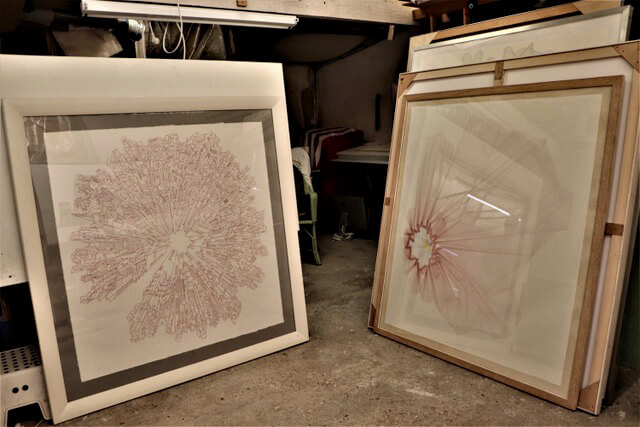
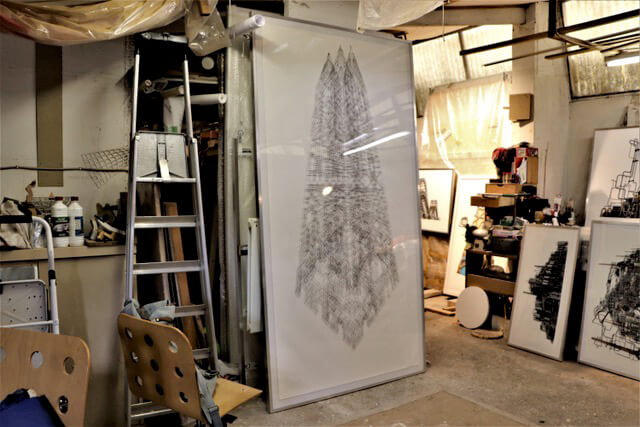
As an artist, how do you approach the concept of “spiritual nature” in your work? What drives you to explore this aspect through your art?
I think there’s a deeply metaphysical aspect to the process of creating art. Art, in my view, is not merely a form of entertainment or a distraction from daily concerns like television. It goes far beyond that; it is profoundly human, the very essence of humanity. It’s a human activity, created by humans for humans, and it serves as an expression of our human nature. For me, art is a way to share the artist’s unique vision of life with others. Through art, artists can present an alternative perspective, allowing people to see things differently from their usual viewpoint. It’s a means of communication, bridging the gap between the artist and those who may not share the same vision. This exchange works both ways; the artist is influenced by interactions with others and what they share, which can stimulate new visions and ideas.
Your sculptures convey a sense of movement and dynamism despite being static drawings. How do you achieve this sense of energy and constant change within your artwork?
Two crucial elements at play here are transparency and visual interaction. Transparency allows for the blending of different elements, resulting in a complexity that evokes a sense of movement within the artwork. The piece gains an energy of its own, primarily through the details infused into it. Even when one moves, the elements may appear to be in motion, although they remain static. This phenomenon generates a captivating energy within the artwork. In my perspective, a work of art should possess its own identity, standing independently. As an artist, it is my responsibility to imbue the piece with essential elements, giving it a distinct character that beckons a response from the viewers. The artwork should demand reactions and engagement from the spectators. It is this interplay between the artwork and the observer that completes the artistic experience, creating a dynamic exchange of emotions and ideas.
Your sculpture “Skyline” displayed at the roundabout at “les Fouchards” is a fascinating piece that evokes the concept of transparency and invites viewers to explore an imaginary world. Could you share your inspiration behind this artwork and how you achieved the interplay between the sculpture and its surroundings?
I find immense significance in transparency as a concept, and it is evident in many of my works. One clear example is the sculpture “Skyline” displayed at the roundabout at “les Fouchards,” France. This piece, resembling a city or what a friend once described as a “Celestial Jerusalem,” embodies the idea of transparency. It allows the environment surrounding the sculpture to interact with its primary forms, making it a focal point for continually evolving activity. The piece is always changing, reflecting the dynamic nature of its surroundings.
Rather than leaving spectators mystified by its mystery and strangeness, I encourage them to use the symbols presented in the sculpture as a key to enter into a different world—the imaginary one of the artists. Through this process of engagement and interpretation, viewers can delve into the parallel world that my art seeks to create. The exhibition of “Skyline” exemplifies my exploration of transparency and the invitation to explore the realms of imagination within my artwork. This continues to be a central theme in my creative journey.
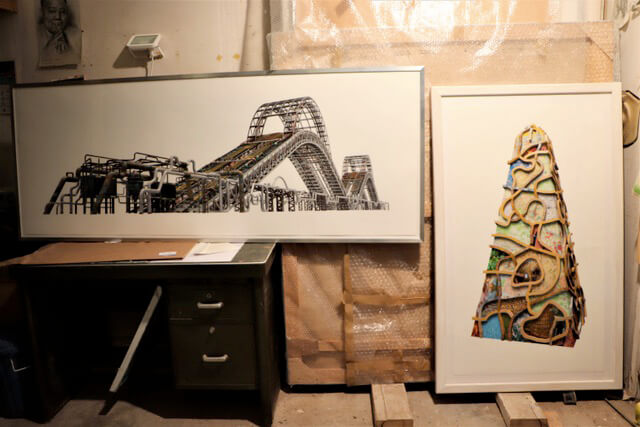
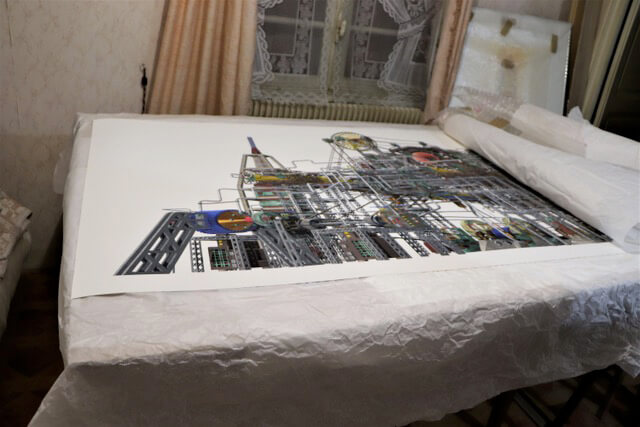
The industrial complexes you draw often carry a history of both progress and decline. How do you infuse these dichotomies into your sculptures, and what message do you intend to convey through them?
As an artist, I often find myself drawn to industrial complexes, which carry a rich history of both progress and decline. When I create sculptures inspired by these structures, I seek to infuse the essence of these contrasting elements into my work. My intention is to convey a profound message through the dichotomies present in these industrial forms. The industrial complexes were originally built with the purpose of driving progress and generating employment opportunities. They had a direct impact on the lives of the people who worked there. However, for this progress to sustain, there was a need for continuous investment in technology and an ability to adapt to the evolving world. Failing to do so leads to the risk of becoming obsolete, losing their relevance over time. I witnessed this issue first-hand with a factory located near my residence. Unfortunately, they did not take the necessary steps to renovate or modernize the facility. As a result, it gradually lost its relevance and became outdated. Eventually, it had to be torn down. In my sculptures, I aim to capture the essence of these industrial complexes’ rise and fall, highlighting the beauty in their functionality and design, but also the vulnerability in their susceptibility to becoming irrelevant if not properly maintained and adapted.
What kind of emotions or feelings do you experience while creating these chimeric structures? How do these emotions manifest in the final artwork?
Indeed, creating art is both a challenge and a pleasure for me. It serves as a means to engage my brain and keep it flexible, constantly pushing its boundaries. I embrace the idea of utilizing my brain to the fullest extent possible, aiming to go beyond the purported 15 percent of its capacity that is commonly believed.
You mentioned that your drawings are not a representation of any known reality. How important is it for you to push the boundaries of reality and challenge viewers’ perceptions of the world through your art?
Pushing the boundaries of reality and challenging viewers’ perceptions is indeed important to me, but only to a certain extent. I want my drawings to maintain a connection with the subject matter that interests me. There’s a line I don’t want viewers to cross, where they interpret the work in any way they please, leading to complete abstraction. I aim to retain a dialogue with the audience, and if they can freely interpret the art without any reference to my intentions, then my role as an artist becomes obsolete. In the past, there used to be more meaningful exchanges and discussions between the audience and the artist, but nowadays, it seems to have transformed into mere diversion. Preserving a sense of direction in the interpretation of my work is essential to uphold the essence of the artistic dialogue.
The term “chimeric” connects to mythical creatures. Do you see any symbolism in your artwork, drawing parallels between the mythical and industrial realms?
No, I don’t believe so. While my drawings are certainly imaginary, I don’t draw direct parallels to mythical creatures. There might be elements of imagination, but I don’t delve into the mythical realm explicitly. I prefer to stay firmly anchored in the present and draw inspiration from the world around me, exploring the imaginative possibilities within the context of the contemporary.
How do you envision the relationship between the viewer and your art? What kind of experience or impact would you like your sculptures to have on those who observe them?
I like people entering into my world and whatever they find in there, that’s what they find, and that’s also why they need to understand it first.
Your work seems to explore the legacy and impact of industrialization on communities. How do you see art’s role in preserving memories, reflecting on the past, and inspiring discussions about the future?
For me, industrial and geometric elements are fundamental aspects of life, and having a connection with these elements allows for continued invention, imagination, and progress.
Could you describe any specific challenges you faced while bringing your vision to life through art, and how you overcame them?
The biggest challenge is getting people interested. Being an artist is inherently challenging as we live on the edge of the world. We don’t conform to the mainstream; instead, we observe and commentate through an abstract language. It can be difficult to get people to engage in that dialogue with us and enter our artistic world.
Have you ever encountered any surprising or unexpected interpretations of your chimeric structures from viewers, and how did that affect your understanding of your own work?
Yes, there was a woman at one of my exhibitions who was writing a story for children and attempted to explain my work. To her surprise, as she delved into interpreting it, she found herself deeply trapped in one of my pieces. This unexpected reaction led her to take a week-long leave of absence.


With your mention of the Ukrainian situation and the symbolism of the Azovstal complex, could you talk more about the role of art in conveying powerful messages or expressing resistance to societal issues?
As an artist, I see myself as both an observer and a participant in society. I am deeply influenced by the events and issues that unfold in the world around me. The Ukrainian situation and the symbolism of the Azovstal complex struck me profoundly, particularly when confronted with the level of destruction in a structure that was originally meant to foster life. It is indeed challenging not to be deeply moved by such an event.
Additionally, could you please share what you are currently working on and where these works will be exhibited or shown?
At the moment, I am working on a commissioned project for the city of Clairefontaine. The project involves creating a series of digital drawings as a tribute to 10 individuals who have been associated with Clairefontaine’s past and present. These notable figures include Rachmaninov, Chagall, Jean-Paul Belmondo, and others. The finished digital drawings will be glued to the sidewalk surrounding the central marketplace of Clairefontaine.
Joe, thanks for speaking with me today!
Simone Kussatz – Bagnolet (France), August 6th, 2023
Simone Suzanne Kussatz is a freelance cultural journalist and founder of ARETE.




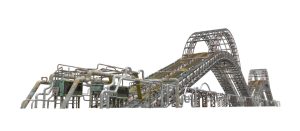
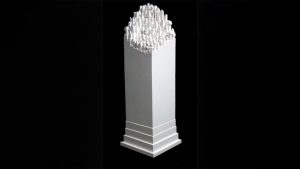
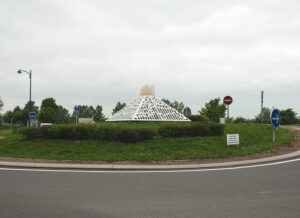
Hello Joe
Superbe et très complet
Jacques